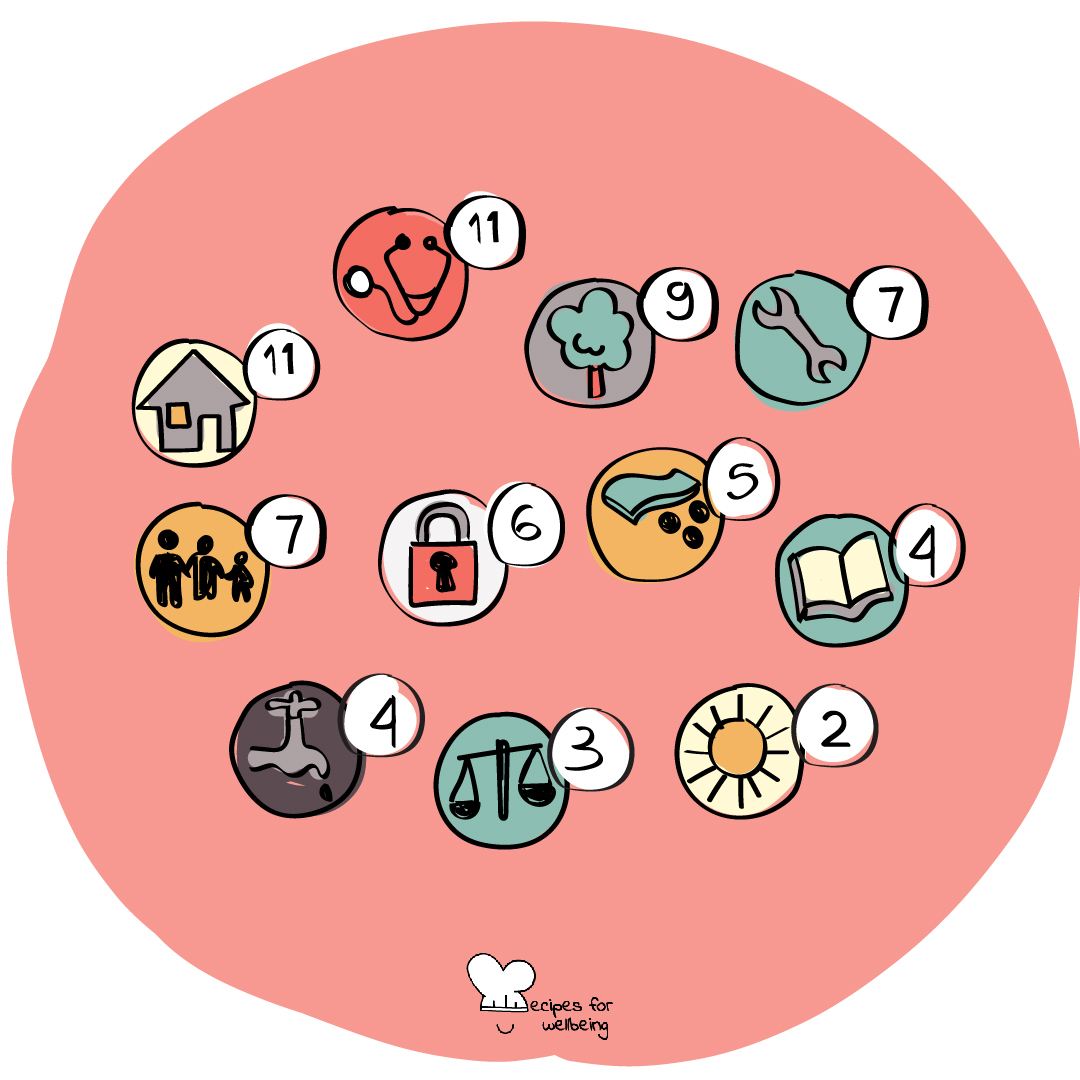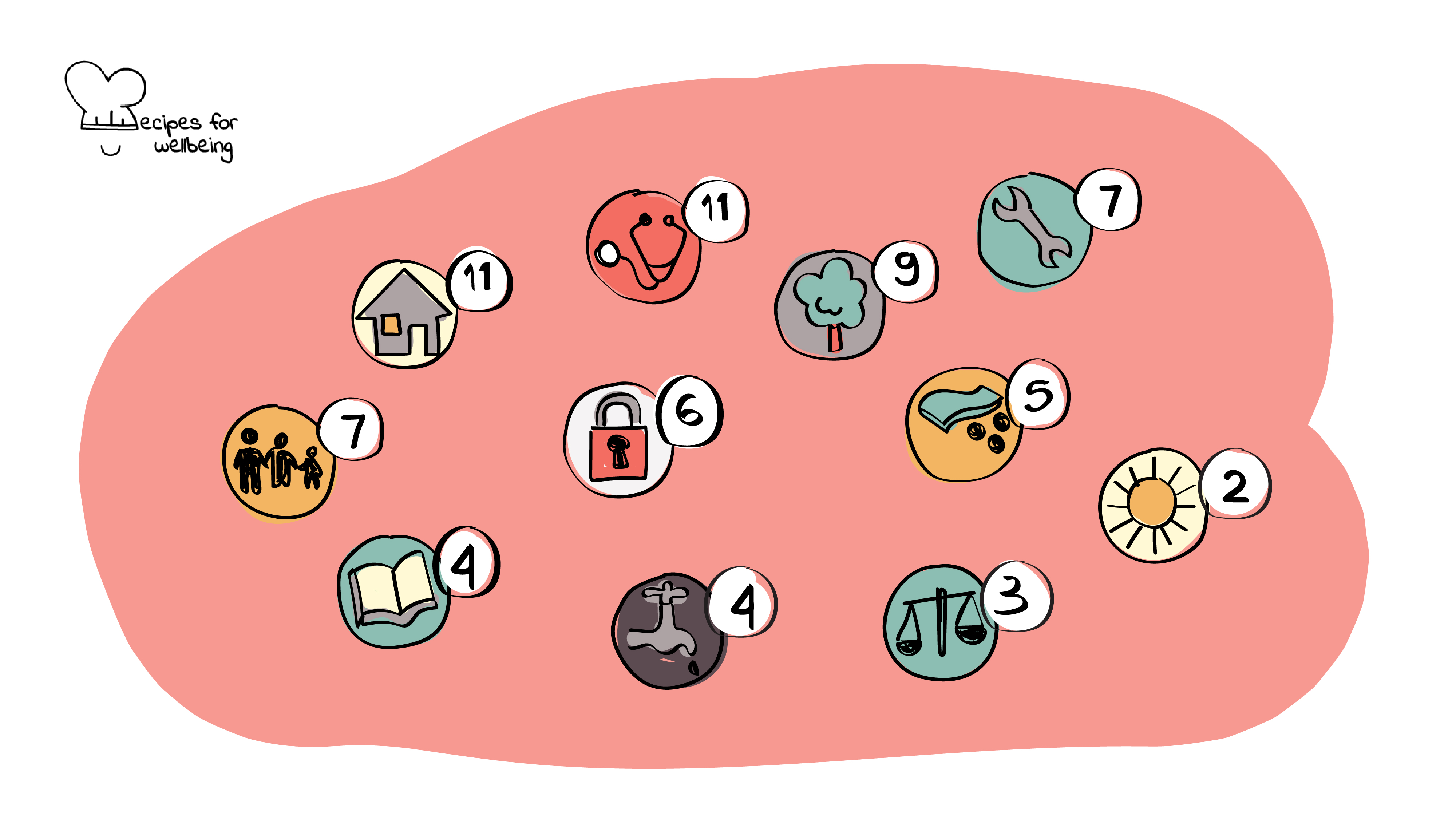
The Humankind Index
We don’t have to do it all alone, we were never meant to. ―Brené Brown
👥 Serves: No limits of people
🎚 Difficulty: Medium
⏳ Total time: 5–7 hours
🥣 Ingredients: Relationship with local community, data analysts, and tools such as online survey platform or people to run street stalls for gathering information
💪 Nutritional values: Growth, Connection, Collaboration, Hope, Support

The Humankind Index
📝 Description
Measure wellbeing using Oxfam’s Humankind Index.
Oxfam’s Humankind Index for Scotland, United Kingdom, was crafted in 2011 to assess Scotland’s prosperity from a holistic place, taking the main focus away from the economic model, Gross Domestic Product (GDP), to measuring the real wealth of the country – what is important and what matters to Scottish people.
The Oxfam Humankind Index believes the economy should serve the people, rather than the other way around. The index strives to re-calibrate prosperity through the distribution of growth supporting the livelihoods for many, not profits for the lucky few. The goal is to decrease examples of extremes in money, wealth, esteem, status, power, and position.
This recipe will guide you to crafting a Humankind Index in your own community. It has been adapted by the word from Oxfam Scotland by our wellbeing content writer collaborator Marissa Del Mistro.
👣 Steps
Step 1 – Consultation (2–4 hours)
To design the Oxfam Humankind Index, Oxfam Scotland worked in consultation with a range of partners including the Craig head Institute, Northern Star, and the New Economics Foundation. The consultation process engaged nearly 3,000 people from across Scotland, with a significant effort to include rarely heard people, whose interests are often marginalised within formal policy-making and whose voices are often absent from decisions that impact them. This participatory, deliberative, and inclusive consultation process was designed to agree on a set of priorities on what people require to live well in their communities.
This first step is of huge importance, especially imploring the values of working with a wide participatory group. You may choose to work with other organisations like Oxfam Scotland did or not.
To reach a wide range of diverse people, its best to implore varied consultative strategies, such as:
- Focus groups
- Community workshops
- Interactive street stalls
- A Council Circle
- Online surveys
- Representative polls
- Work in partnership with local organisations to recruit participants
To be inclusive, street stalls, for example, can be set up in commonly deprived or rural neighbourhoods. To remove barriers, consider factors that may hold different people back, by offering free transportation to and from the consultation, offering free childcare, and/or compensation for their time through cash or gift cards to grocery stores. To determine what matters to people, questions that can be included in the consultation can be:
- What relationships are most important for a good life?
- What do you value in your community?
- What is required for a good home life?
- What difference does education make to living a good life?
- What matters when it comes to having money?
- What services are most important for your community?
- What resources and assets are available to men and women in the community?
- What are the barriers?
These questions can be adapted to your community and its unique needs. If you would like some inspiration on creating questions, you can refer to our recipe “Asking powerful questions”.
If you want to enhance your understanding of the folks in your community that are experiencing poverty, you may benefit from our recipe on Multidimensional Poverty Index, which researches poverty in a way to identify how people experience poverty, by assessing non-income-based dimensions of poverty.
Step 2 – Process the results of the consultation (2 hours)
The outcome of the consultation will be a broad range of key factors that participants identified as what they require to live well in their communities.
These key factors are called ‘sub-domains’, and can be factors such as affordable/decent/safe and secure housing, living somewhere you can enjoy being outside with a clean and healthy environment, feeling that you are and those you care about are safe, and having a secure source of money, etc.
The next steps are to give each sub-domain a ‘weight,’ based on respondents’ answers. The higher the weight, the more important the sub-domain is to the participants.
Step 3 – Determine your Humankind Index score (1 hour)
The next step is to determine the Humankind Index score customised to your community. Using the data from steps 1 and 2, the sub-domain data should now be matched to the most trustworthy and relevant measures from public data. You can access data through non-governmental organisation data or statistics available from the government of your area.
For example, Oxfam Scotland implored data from the Scottish House condition survey, The Scottish Social Attitudes Survey, and The UK Office for National Statistics. Using affordable/decent/safe and secure housing as an example, Oxfam Scotland cross-examined their local data, to determine that 56% of people reported being “very happy” with their home. Sure, this measure may not distinguish between the three aspects of the previous sub-domain as such, but instead captures overall satisfaction with housing.
For you to determine your index score, you will need to multiply the measurement determined by the data by the given weight (determined in step 2) and then add them together for your overall Humankind Index score. It will likely be a large number in the thousands.
To then determine the percentile contribution of each sub-domain to the index, you will want to divide the score for each subdomain, determined by the previous equation, by the total index score and multiply that number by 100.
The % incorporates both the weighting and the measure, showing which sub-domains are contributing the most to wellbeing in your area and which need attention.
Step 4 – Using the data (ongoing)
Ultimately, the scores determined in step 3 gain their value and importance over time. To compare and see the growth of an area, it is best to repeat the process after one year to compare and contrast. Changes made may not be dramatic but there should be a steady improvement.
The goal of the index is to foster debate, help to lobby for new, appropriate policies and do additional research on how to improve the livelihoods of those in the community. It’s imperative to see the difference in helping the community.
Returning to Oxfam Scotland, they used their index to lobby the Scottish Government to focus on what really matters, and to make more informed decisions for the country. Together with WWF and Friends of the Earth Scotland, they called on civil society organisations to work alongside them to create a vision for the “Purpose of Scotland”, taking into account more than just economic growth. This was successful and they were joined by 31 organisations and contributed to the review of the Government’s National Performance Framework.

